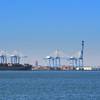A Tidal Wave of New Regulations
Ballast Water Management
The management ballast water discharges began with the enactment of the Nonindigenous Aquatic Nuisance Prevention and Control Act of 1990 (NANPCA) as an effort to prevent the introduction of additional invasive species into the Great Lakes. Since then, NANPCA was amended by the National Invasive Species Act of 1996 and the issue has progressed over the intervening years to a much larger campaign to regulate all vessel discharges into U.S. waters. Ballast water management has been the subject of litigation, regulation, and legislation at the state and federal level. The issue remains to be played out before the courts and Congress.
Although the United States appealed the case to the Ninth Circuit Court of Appeals, EPA has, in the meantime, begun a rulemaking to institute a permitting process for discharges of pollutants incidental to the normal operation of vessels. On June 21, 2007, EPA published a notice requesting comments and information on how to issue permits for vessel discharges. An EPA official stated that the new permits could cover more than 18 million vessels, more than all other point sources regulated by EPA.
Senator Ted Stevens (R-AK) and Representative Don Young (R-AK) introduced companion bills (S. 2645 and H.R. 5594) early this year, entitled the “Vessel Discharge Evaluation and Review Act.” If enacted, these bills would render the District Court ruling moot by removing from EPA the authority to regulate incidental discharges from commercial and recreational vessels, and giving separate authority to the Coast Guard to establish a new uniform national discharge standard in lieu of any permit program. Although it is difficult to predict at this stage if the proposed legislation has much chance of success, vessel owners and operators should closely monitor this legislation in conjunction with the EPA rulemaking and appeal, and should also seriously consider whether it is in their interest to lend support to this legislative proposal.
On a parallel track, Congress is considering new ballast water management legislation. Ballast water management bills have been reported from their respective Congressional committees and are awaiting full House and Senate consideration. The Ballast Water Treatment Act of 2007 is incorporated in Title V of H.R. 2830, the Coast Guard Authorization Act of 2007. The Senate has reported a separate bill, S. 1578, to amend NANPCA. Both bills would track closely the Coast Guard’s current ballast water management scheme, and would address the critical issue of relation to state laws or preemption. Both bills would allow state regulation of ballast water management provided the regulation does not conflict with federal standards, and, in the case of the Senate bill, does not impose an undue burden on interstate commerce. The Senate bill also has an explicit provision granting the Coast Guard the sole authority to regulate ballast water discharges, thereby superseding EPA authority at least to the extent the discharges introduce aquatic nuisances into the marine environment.
Ship Emissions
Ocean-Going Vessels
In an effort to combat air pollution in California, on January 1, 2007, the California Air Resources Board (CARB) began enforcing state regulations limiting emissions of particulate matter, nitrogen oxide, and sulfur oxide from the auxiliary diesel engines of ocean-going vessels operating within 24 miles of California’s coast. The regulations were challenged by the Pacific Merchant Shipping Association and in August 2007, the District Court held the regulations were preempted by the Clean Air Act. CARB appealed and the Ninth Circuit allowed CARB to begin enforcing them again in October 2007 pending the outcome of the appeal. On February 27, 2008, the Ninth Circuit affirmed the lower court’s ruling, confirming that the regulations indeed were preempted by the Clean Air Act. While California had the ability to petition EPA to allow California to issue regulations, California did not follow this procedure and could not on its own issue these standards to regulate vessel emissions.[1] On that date, CARB stopped enforcing its regulations, but announced about two weeks later on March 10, 2008, that it would again begin enforcement “[b]ecause of the significant adverse health impacts from human exposure to the air pollutants emitted by ocean-going vessels in California waters,”[2] pending the resolution of its request for a rehearing to the Ninth Circuit. Thus, while this on again, off again, and on again rule winds its way through the judicial system, shipowners remain challenged at keeping track of compliance obligations.
In the meantime, EPA has begun a rulemaking on the development of more stringent emissions for marine diesel engines on ocean-going vessels. (Category 3 marine diesel engines with cylinder displacements of 30 liters or more.) EPA is considering application of these requirements to both U.S. and foreign-flag vessels. In addition, the International Maritime Organization is considering amendments to MARPOL Annex VI to achieve greater reductions in the emission of air pollution from ships. It is therefore only a matter of time before EPA and the international community adopt more stringent regulation of ship emissions, though it remains unclear whether more stringent regulation at the international and federal level will satisfy California.
The California Senators, Barbara Boxer and Diane Feinstein, displeased with the pace of the EPA rulemaking, have also introduced legislation to amend the Clean Air Act to reduce air pollution from marine vessels. S. 1499, the Marine Vessel Emissions Reduction Act of 2007, was introduced in 2007 and referred to the Committee on Environment and Public Works. (The companion bill in the House is H.R. 2548.) The Boxer-Feinstein bill would require EPA to adopt more stringent standards for sulfur in fuel, and establish new standards for emissions from new and in-use engines. Senator Boxer, Chair of the Senate Committee on Environment and Public Works, conducted a hearing on this bill on February 14, 2008. At the hearing, the witnesses recognized the need to do something to curb air pollution from vessels, but EPA and industry witnesses urged the Subcommittee to work through the IMO working group on new emission standards under MARPOL Annex VI rather than unilaterally.
The United States is not yet a party to MARPOL Annex VI. Implementing legislation has been passed by the House of Representatives, but is still pending in the Senate.[3] This legislation could be incorporated in the Coast Guard authorization bill later this year or separately enacted.
Coastal and Great Lakes Vessels
Finally, EPA just announced new emissions standards for newly manufactured marine diesel engines and remanufactured commercial marine diesel engines above 600 kilowatt or 800 horsepower with displacement less than 30 liters per cylinder installed on U.S.‑flag vessels. These rules will apply to propulsion and marine auxiliary engines typically used on recreational and small fishing vessels, towboats, tugboats, and Great Lakes freighters. EPA Administrator Johnson “predicted that the restrictions, when fully in place by the year 2030, would help prevent 1,400 premature deaths a year and save billions of dollars in health costs.”[4] Environmental organizations and marine engine manufacturers were both supportive of the new rules.[5]
Oil Pollution
Just when you think it’s safe to go back in the water and that the subject of oil spills has been exhausted, another spill occurs in U.S. waters and attention is refocused on the subject. This, despite the fact that Congressional Research Service recently released a report concluding that while imports and consumption of oil have increased, the number and volume of oil spills (particularly spills from ships) have decreased.[6]
Of course, the Supreme Court will soon be weighing in with its decision in the case of Exxon Shipping v. Baker. The assessment of punitive damages against Exxon as a result of the 1989 catastrophic oil spill in Prince William Sound, Alaska, is pending before the Supreme Court. The Court heard oral argument on February 28, 2008, and a decision should be rendered before the Court’s term ends in June 2008.
The incident of the Cosco Busan in San Francisco Bay has precipitated further Congressional attention on the safety of shipping. On November 7, 2007, the container ship Cosco Busan hit the Bay Bridge, spilling over 50,000 gallons of bunker fuel. In the aftermath, Senators Boxer and Feinstein introduced two bills intended to prevent future accidents. One, S.2430, the Boxer-Feinstein Maritime Emergency Prevention Act, would give the Coast Guard the authority to order ships to change speed or course in the event of an emergency or hazardous condition. The second, S. 2429, or a bill to amend the Oil Pollution Act of 1990, would raise the liability limits for cargo ships to the same level as oil tankers and allow deposits in the Damage Assessment Restoration Revolving Fund to be invested in interest-bearing obligations of the United States. Senator Lautenberg has introduced two related bills, requiring double hulls on bunker fuel tanks on non-tank vessels, phase out federal liability limits for oil spills from single-hull tankers, and double the liability limits for single-hull tankers and tank barges. S.2699 and S.2700 were both introduced on March 4, 2008, and referred to the Senate Committee on Commerce, Science, and Transportation.
The House Transportation and Infrastructure Committee has scheduled hearings on the Cosco Busan spill for April 10. Once again, elements of these new oil spill bills could surface in the final Coast Guard authorization bill.
Conclusions
Congress is paying close attention to the regulation of all forms of discharges and emissions from vessels that ply U.S. waters and call on U.S. ports. If Congress fails to act, states will almost certainly do so as has been evidenced in the past in Washington, Alaska, California, Massachusetts, and Rhode Island, among others. An increasing number of states have begun to regulate ballast water discharges, and as we can see in the case of California, have a longstanding interest in regulation of vessel emissions of particulates and other pollutants. State regulation of these issues will continue unless clearly preempted by federal laws and regulations.
As Congressional and world attention turns increasingly to the subject of climate change, we can anticipate even closer attention being paid to air pollution from vessels. Again, unless the international community acts with one voice, individual nations and states will adopt regulations that they believe to be in their best interests.
(Reprinted with Permission from the May 2008 edition of Maritime Reporter & Engineering News)
Footnotes
[1] A further discussion of this important decision is found in Blank Rome’s Maritime Development Advisory No. 6 of March 2008 at www.BlankRomeMaritime.com.
[2] March 10, 2008 notice by CARB to Continue Enforcement of the Ocean-Going Vessel Auxiliary Diesel Engine Regulation. The CARB notice is described more fully at Maritime Developments Advisory, March 2008 (No.9) at www.BlankRome.com.
[3] H.R. 802 passed the House on March 26, 2007, and was referred to the Senate Committee on Commerce, Science, and Transportation. A markup of the House bill is imminent in the Senate as of this writing.
[4] Reported in “In Revising Clean Air Rules, E.P.A. Draws Praise and Criticism in the Same Week”, New York Times, Mar. 15, 2008 at A14.
[5] NRDC said it was pleased with the new regulations, NYT, supra. Cummins, Inc., on behalf of the Engine Manufacturers Association, affirmed the industry’s support of the EPA rule. www.cargobusinessnews.com.
[6] CRS Report – Oil Spills in U.S. Coastal Waters, RL 33705 (2/5/08).













